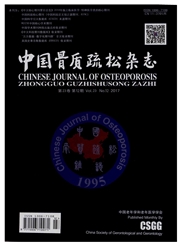

 中文摘要:
中文摘要:
目的 通过研究沉默信息调节因子1(SIRT1)基因敲除对骨关节炎小鼠VEGF/AKT通路的作用,探讨骨关节炎关节软骨退变的可能机制。方法 将小鼠分为两组:SIRT1+/+小鼠骨关节炎模型组(A组,n=6);SIRT1-/-小鼠骨关节炎模型组(B组,n=6)。荧光定量聚合酶链反应检测SIRT1基因表达情况;HE染色、番红O-固绿双染色观察膝关节软骨形态结构改变,Mankin评分评价膝关节关节软骨退变,免疫组化染色检测膝关节软骨细胞中SIRT1、VEGF和AKT蛋白水平。结果 B组SIRT1 m RNA表达量为2.24417±1.316569,明显低于A组(P〈0.01)。HE染色和番红O-固绿双染色结果显示,B组膝关节关节软骨退变明显,Mankin评分分值为9.8333±1.94079分,明显高于A组(P〈0.05),B组SIRT1、VEGF和AKT免疫组化染色积分分别为3.3333±1.96638、10.0000±2.44949和1.3333±1.21106,B组SIRT1蛋白表达与A组相比差异不显著(P〉0.05);B组VEGF蛋白表达明显高于A组(P〈0.05);B组AKT蛋白表达明显低于A组(P〈0.01)。结论 SIRT1基因敲除可能通过激活VEGF/AKT通路加重骨关节炎关节软骨的退变,因此SIRT1基因可能对骨关节炎起到保护作用。
 英文摘要:
英文摘要:
Objective To investigate the effect of SIRT1 gene knock-out on VEGF/AKT pathway in osteoarthritis mice, and to explore its role in the pathogenesis of cartilage degeneration in osteoarthritis. Methods The mice were divided into 2 groups: SIRT1 +/+ mice osteoarthritis group (Group A, n = 6) and SIRT1 -/- mice osteoarthritis group (Group B, n = 6). FQ-PCR was used to detect the mRNA expression of SIRT1. HE staining and Safranin O-Fast Green staining were used to observe the morphological changes of the articular cartilage of the knee. The Mankin' s score was used to evaluate the degree of articular cartilage degeneration. Immunohistochemical staining was used to detect the protein expressions of SIRT1, VEGF, and AKT. Results The mRNA expression of SIRT1 in Group B was 2. 24417 ± 1. 316569, which was significantly lower than that in Group A (P 〈 0.01 ). The HE staining and Safranin O-Fast Green staining showed that the articular cartilage in Group B degenerated obviously, with Mankin' s score of 9. 8333 ± 1. 94079, which was significantly higher than that in Group A ( P 〈 0. 05 ). The immunohistochemical staining integrals of SIRT1, VEGF, and AKT in Group B were 3. 3333 ±1. 96638, 10. 0000 ± 2. 44949, and 1. 3333 ± 1. 21106. The protein expression of SIRT1 in Group B was not significantly different from that in Group A (P 〉0. 05). The protein expression of VEGF in Group B was significantly higher than that in Group A ( P 〈 0.05 ), but the protein expression of AKT in Group B was much lower than that in Group A (P 〈 0.01 ). Conclusion Knocking-out SIRT1 may aggravate cartilage degeneration in osteoarthritis through VEGF/AKT signal pathway activation. Therefore, SIRT1 may play a protective role against osteoarthritis.
 同期刊论文项目
同期刊论文项目
 同项目期刊论文
同项目期刊论文
 期刊信息
期刊信息
